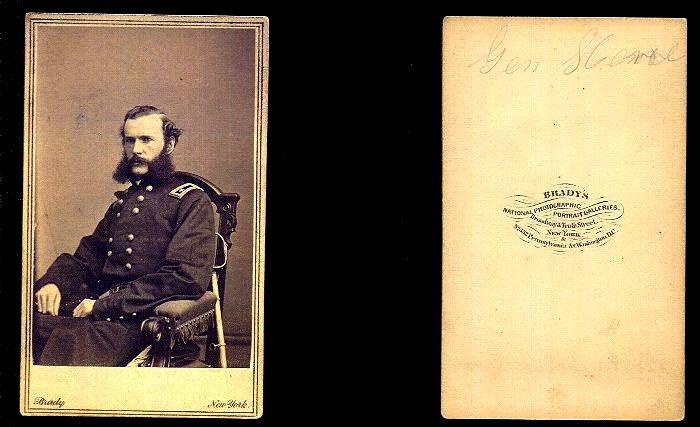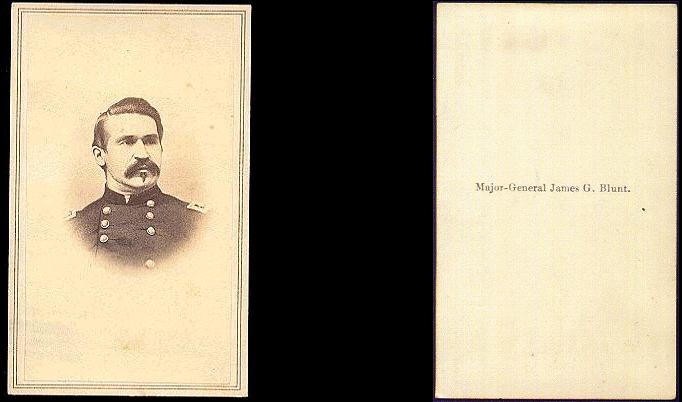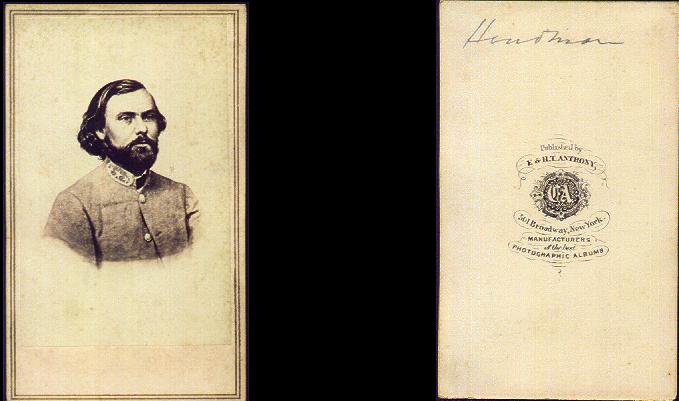

And, finally, here is Confederate Major-General Thomas C. Hindman, who commanded the




Fall Ozark Campaign of 1862
The summer recruitment campaign of 1862 in Missouri was a mixed success for the
Confederate army. Victories at Lone Jack and Independence were offset by
crushing defeats in the central and northern parts of the state. By the fall,
Southern forces were once again confined to SW Missouri and NW Arkansas.
However, the arrival of Confederate General Thomas Hindman served to revitalize
the war effort and a new army was forged, the 1st Corps, Army of the
Trans-Mississippi. During this time, the Federals formed the Army of the
Frontier from the merging of the Kansas and Missouri Departments, and placed the
new army under General John Schofield.
Newtonia
While Hindman met with his superior, General Rains was placed in temporary
command in Arkansas. Disobeying orders, Rains advanced his cavalry (under the
command of General Douglas Cooper) into SW Missouri. The Federals responded by
forming a provisional division of three brigades under General Frederick Salomon
to counter the Confederate advance. Readying his command for a fight, Cooper
ordered a concentration of his forces at Newtonia, a SW Missouri town
strategically located at a junction of six roads.
Kansas General James Blunt moved immediately to counter this move. He placed two
of his brigades under the command of Gen. Frederick Salomon and ordered them to
move directly to Newtonia by the Sarcoxie Road. A third brigade of Missouri
militia-Missouri State Militia (MSM) and Enrolled Missouri Militia (EMM)-was
located at Mt. Vernon, a small town northeast of Newtonia. Rather than march
directly to Newtonia, the militia brigade under Col. George Hall was directed to
take a much longer route, crossing over to the Sarcoxie Road far to the north
and following the rest of the division to Newtonia.
A part of Cooper's Confederate cavalry was camped at Newtonia, with
reinforcements located within supporting range to the south. The area
immediately surrounding Newtonia was dotted with fields and orchards. Several
wood and stone fences just west of town would provide excellent defensive
positions for the cavalry and its supporting artillery.
Early on the morning of September 30, the vanguard of Salomon's division
advanced to Newtonia and found the heights northwest of town unoccupied. After
skirmishing throughout the morning and early afternoon, the rest of Salomon's
division arrived and deployed on the high ground. Hall's militia brigade was two
hours behind and missed the fight. The Battle of Newtonia was characterized more
by heavy skirmishing in the fields north and west of town and artillery
bombardment rather than grand charges. Without his third brigade and after
suffering heavy casualties, Salomon decided to withdraw, leaving the field to
the Confederates, who claimed victory.
Cane Hill and Prairie Grove
After Newtonia, Cooper's provisional division was broken up. The Indian units
fell back into the Indian Territory and were defeated by a detachment of Blunt's
forces at Old Fort Wayne on October 22nd, effectively removing them from the
Confederate order of battle for the upcoming campaign. The way was open for a
Federal invasion of Arkansas. General Blunt and his Kansas Division were ordered
to hold NW Arkansas while the other two divisions of the Army of the Frontier
were concentrated south of Springfield, Mo. Accordingly, Blunt moved into
Arkansas and camped at Rhea's Mill.
Seven miles to the south at Cane Hill, was camped Confederate General John S.
Marmaduke's newly-formed cavalry division. Marmaduke's division was comprised of
two brigades and an independent regiment of Missourians. Recently, General
Hindman had received approval for offensive action but his army was still
unorganized. Therefore, the cavalry division was stationed at Cane Hill to
protect the still-forming army and prevent Federal patrols from gaining
intelligence. From here Federal movements into Arkansas and/or the Indian
Territory could be monitored.
Seeing an opportunity to smash the Confederate cavalry, General Blunt moved
quickly, putting his division on the direct road to Cane Hill. By 10 am on
November 28, the Kansas division arrived at the north end of Cane Hill. General
Blunt and his escort raced to the front and opened the battle. When the Union
forces struck, Marmaduke's division was not concentrated for defense. Col. JO
Shelby's Iron Brigade was in line across Cane Hill's north end while the rest of
the division was camped about a mile behind. Blunt used his superiority in
numbers and firepower to drive Marmaduke down Cane Hill, over Reed's Mountain,
and through the crucial crossroads at Morrows. After the battle of Cane Hill,
Marmaduke retreated to Hindman's camps in the south.
On the Federal side, General Blunt, realizing how exposed his new position was,
withdrew his Kansas Division back to the north end of Cane Hill. From Cane Hill,
Blunt sent a plea to General Herron to take the 2nd and 3rd divisions and move
to join the Kansas Division in Arkansas. Herron moved immediately, assembling a
provisional cavalry brigade under Dudley Wickersham and sending it along to
Blunt. The horse soldiers reached Blunt's position during the night of December
6.
On that same day, General Hindman began his counteroffensive. Learning of
Herron's approach, Hindman decided to advance and defeat Herron then turn and
destroy Blunt. Leaving a cavalry brigade on Reed's Mountain to occupy Blunt's
attention, the Confederate army marched up the Cove Creek Road to Prairie Grove
Church. Near the church, the advance under Shelby routed the vanguard of
Herron's two divisions and drove them across the Illinois River.
Rather than build on the momentum gained and continue his advance, Hindman
surrendered the initiative to Herron and went over to the defensive, occupying
the heights at Prairie Grove. General Herron quickly forded the Illinois River
and assaulted Hindman's right flank near the Borden House. After initial
success, the attacking bluecoats were counterattacked by dismounted cavalry and
routed. Sensing victory, the Confederates raised a shout and poured downhill
towards the Federal lines, to be promptly slaughtered by the Union artillery.
While Herron and Hindman regrouped to continue the fight on the Confederate
right flank, the Kansas Division arrived on the field. At 10 am Blunt had
realized that the Rebels on Reed's Mountain were not the main body and gathered
up his division for a forced march to Rhea's Mill and on to a junction with
Herron at Prairie Grove. Hindman quickly moved to extend his left to meet Blunt
on that flank. As the sun dipped over the horizon, Blunt's final assault was met
and repulsed by a narrow margin. The Battle of Prairie Grove was over.
Low on supplies and ammunition, Hindman ordered a retreat. As the 1st Corps,
Army of the Trans-Mississippi returned to the Ozarks, it melted away as many
disillusioned conscripts took the opportunity to escape the service. What began
as a promising Confederate offensive turned into a complete disaster with
massive losses in both manpower and equipment. Northern Arkansas would never
again see a Confederate infantry force large enough to threaten the Union hold
on the Ozark region.